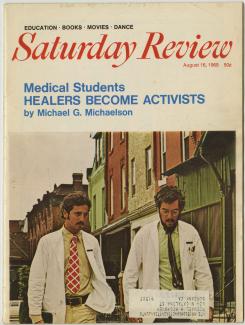These social movements–often youth-led–spilled into all occupations, including the health sciences. Within this milieu, medical students began to organize. The Physicians for Social Responsibility (est. 1961) responded to the nuclear arms race. The Medical Committee for Human Rights (est. 1964) provided medical services to civil rights workers in the South.
These activists were products of their time, breaking from what some saw as an out-dated curricula that did not address sociomedical health studies, community medicine, and preventive care. Racial and class justice, Vietnam, capitalism, abortion, the power of the pharmaceutical industry, and other public health issues informed and intersected with medical student activism.
Keeping with the time, the “medical new left” and other health sciences activists sought out teach-ins and progressive initiatives to help break down formal, hierarchical power structures.
“Some Brief Thoughts on Student Rebellion”
1967-68 School of Public Health and Administrative Medicine [yearbook] : Columbia-Presbyterian Medical Center
New York: Columbia University, 1968
M-Collection Serial S
Student Health Organization (SHO)
In 1965, the Student Health Organization (SHO)–a collective of students in medicine, dentistry, nursing, and social work from twenty-five schools throughout the United States–first assembled to improve health care services for under-served communities. SHO went on to create regional branches and hosted projects for several years.
Originally modeled after the radical group, Students for a Democratic Society (SDS), it was not surprising that SHO members had links to the SDS, as reported in the Chicago Tribune article, “1968 rioters in city aided by U.S. Pay.”[1]
Fearing this association would lead to funding cuts from the federal government, a more sanitized group, Student American Medical Association (SAMA), offered an alternative. SAMA, in turn, gave way to the Institute for the Study of Health and Society (ISHS) in December 1968. Its aims were similar to SHO: to promote the interdisciplinary approach to societal problems in health care, environment, population, drug abuse, racial discrimination, and professional education.
Artist unknown
circa 1967
Michael R. McGarvey papers
This drawing represents the 2nd National Assembly of the Student Health Organization (SHO), hosted by the Albert Einstein College of Medicine (AECOM) in the Bronx, New York City on February 10-12, 1967.
Reports from various Student Health Organization projects
1967-1968
Michael R. McGarvey papers
“1968 rioters in city aided by U.S. Pay,” Chicago Tribune
December 8, 1969
Reporting that four individuals involved with conducting health surveys for federally-funded SHO, had also demonstrated against the Democratic National Convention.
Michael R. McGarvey papers
August 16, 1969
Michael R. McGarvey papers
In this 1969 cover story, the Saturday Review reported that,
“…medical student activism is a fact… Students have begun to question the models and methods of their profession, and to abandon passivity for immediate social action. In December 1967, a hundred students burst onto the floor of an American Medical Association conference in Chicago and accused the organization of plotting to ‘silence’ the anguished cries of the poor.”- page 42
[1] Koziol, R. (1969, December 8). “1968 rioters in city aided by U.S. Pay: 4 students given survey wages”. Chicago Tribune, p. 1.
![cover of 1967-68 School of Public Health and Administrative Medicine [yearbook] : Columbia-Presbyterian Medical Center](/sites/default/files/styles/grid_gallery_thumbnail/public/2021-07/YearbookSPH1968cover_0.jpg?h=c952cb5d&itok=RYgwYTTR)
![“Some Brief Thoughts on Student Rebellion”, 1967-68 School of Public Health and Administrative Medicine [yearbook] : Columbia-Presbyterian Medical Center](/sites/default/files/styles/grid_gallery_thumbnail/public/2021-07/YearbookSPH1968.jpg?h=e290a474&itok=HszLWMht)






